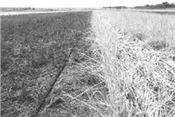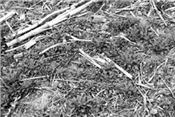|
Fall Management Strategies For Optimizing The Control Of Horseweed
ERIC OSELAND AND DR. KEVIN BRADLEY
COLUMBIA, MO.
Horseweed is one of the most troublesome weeds we encounter in corn and soybean fields in Missouri, and is especially common in no-till environments. In a recent survey of Missouri horseweed populations, we found that widespread glyphosate (group 9) and ALS (Group 2) herbicide resistance exists in horseweed populations throughout the state (see survey results here). Other herbicides such as the synthetic auxins (Group 4; i.e. 2,4-D, dicamba, halauxifen-methyl), saflufenacil (Sharpen®), paraquat (Gramoxone®), and glufosinate (Liberty®, Interline®) are still effective on horseweed assuming plants are 4-inches or smaller (Figure 1) at the time of application. Unfortunately, weather uncertainties in the spring often delay herbicide applications allowing horseweed plants to reach greater heights and therefore require higher rates and/or multiple herbicides for effective control (see previous MU research results here). In short, proactive fall management of horseweed can help prevent horseweed from becoming a major springtime headache.
Fall application of certain herbicides is a popular approach for managing horseweed. These applications can be made with or without a residual herbicide but it is important to note that a residual herbicide applied at this time of year will not act as a substitute for springtime residual herbicide applications targeted for waterhemp or Palmer amaranth. Some effective fall-applied herbicides for horseweed that have residual activity include products that contain chlorimuron (Canopy®, Canopy EX®, Cloak®, Cloak Ex®, Authority XL®, Fierce XLT®, etc.), or other group 2 herbicides such as Basis Blend®, Autumn Super®, etc. All of these products should be combined with 2,4-D and/or dicamba as the base for the control of emerged plants control as well as glyphosate for the control of other emerged weed species. Metribuzin can also increase the control of horseweed.
The planting of a cover crop in the fall offers many advantages even fall applied herbicides cannot provide including soil health benefits, nutrient trapping, and erosion control. Cover crops like cereal rye have also been shown to be highly effective in suppressing the emergence of horseweed and other winter annual weeds through the fall and into the early spring (Figure 2). Recently, weed scientists at Virginia Tech and the University of Kentucky have published results of their research pertaining to the effects of cover crops on horseweed. In one of these studies, weed scientist at Virginia Tech reported up to 96% control of horseweed at the time of soybean planting through the use of cover crops alone (Figure 3; Pittman et al. 2019). They also concluded that cover crops can perform as well or better than some common fall-applied herbicides for horseweed. While cereal rye is one of the most popular cover crop options, these authors also found that other cover crops such as crimson clover or hairy vetch, or some combination of these cover crops with cereal rye or forage radishes can suppress horseweed at levels similar to cereal rye. However, in our own research in Missouri we have found that the use of cereal rye typically provides some of the most consistent winter annual weed control across various environments and also can provide some degree of summer annual suppression. It is also important to select cover crops that do not winter kill. For example, tillage radishes and winter oats do not provide the same level of weed suppression in our studies due to their tendency to winter kill.
In a separate but similar study that was recently published in the journal Weed Technology, weed scientists in Kentucky evaluated an integrated approach for the control of horseweed using cover crops and fall herbicide applications alone and in combination (Figure 4; Sherman et al. 2019). In this research, the authors found that cover crops performed better than fall herbicide applications and that there was no real benefit of using a combination of both cover crops and fall herbicides together. However, fall herbicides in combination with cover crops did provide better horseweed control later in the season but the level of horseweed control achieved from any combination of fall herbicides and cover crops this late in the season would still require the use of an additional burndown application prior to planting. See this article to read about our previous research evaluating herbicide termination programs for cover crops. ∆
ERIC OSELAND: M.S. Student Division of Plant Sciences, University of Missouri
DR. KEVIN BRADLEY: Associate Professor, University of Missouri

Figure 2 Cover crops alone can provide substantial control of horseweed and other winter annual species.

Figure 1 Horseweed basal rosettes in corn residue. Control is
optimized when herbicides are applied to plants at this stage of growth.
 Figure 3 Cover crop and fall herbicide application effect on horseweed density prior to spring cover crop termination. Cover crop species did not differ in the level of horseweed control achieved prior to cover crop termination in the spring. Additionally, no differences were observed when a single cover crop species was planted versus a cover crop combination. In some, but not all cases, cover crops performed better than fall herbicide applications. Figure 3 Cover crop and fall herbicide application effect on horseweed density prior to spring cover crop termination. Cover crop species did not differ in the level of horseweed control achieved prior to cover crop termination in the spring. Additionally, no differences were observed when a single cover crop species was planted versus a cover crop combination. In some, but not all cases, cover crops performed better than fall herbicide applications.
Graph taken from Pittman et al. 2019.

(Right) Figure 4 The use of cover crops and fall herbicides to suppress horseweed. Also, results from this research indicated there is no benefit of applying a fall herbicide in combination with cover crops for early season horseweed control. Early spring data was collected on March 31st and May 9th and late spring data
was collected on June 1 and June 5 in 2017 and 2018 respectively. Asterisks indicate significant differences between grouped bars (P<0.001).
Graph was reproduced from data presented in Sherman et al. 2019.
|
|